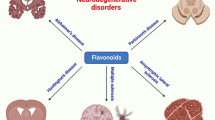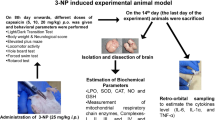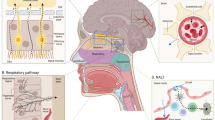Abstract
The present study investigates the role of fish oil (FO)– and butter oil (BO)–enriched microemulsion-based system of galantamine hydrobromide (GH), an anti-Alzheimer drug, for its potential role in brain permeation enhancement and neuroprotection against oxidative stress. Microemulsion (ME)-based system of GH was prepared using water phase titration. The prepared ME was characterized by several physicochemical parameters like particle size, polydispersity index, and ex vivo drug permeation. Cell-based oxidative stress assays and pharmacokinetic studies were performed using C6 glial cell lines, and Sprague Dawley rats, respectively. The optimized ME comprised 5.3% v/v of Capmul MCM EP (as oil),15.8% v/v of Tween-80 (as surfactant), 5.3% v/v of Transcutol P (as co-surfactant), and 73.6% v/v of water (as aqueous phase). The addition of FO and BO resulted in a slight increase in the droplet size and decrease in transparency of ME. Cell-based anti-oxidative stress assays (glutathione assay, nitrite assay, and lipid peroxidation assay) showed the efficacy of formulation in the order of ME, BO ME, and FO ME, respectively. A similar trend was also observed in in vivo animal studies, wherein GH FO ME showed a comparatively higher percentage of drug reaching the brain when administered by intranasal route than by IV route. The study concluded the potential benefits of co-administering FO- and BO-enriched microemulsion is not only enhancing the permeation of drugs across BBB but also improving efficacy against lipopolysaccharide-induced oxidative stress.

Graphical abstract







Similar content being viewed by others
Abbreviations
- AD:
-
Alzheimer’s disease
- ANOVA:
-
analysis of variance
- AUC:
-
area under curve
- BACE 1:
-
beta-secretase 1
- BBB:
-
blood-brain barrier
- CNS:
-
central nervous system
- DHA:
-
docosahexaenoic acid
- DSC:
-
differential scanning calorimetry
- DTNB:
-
5,5′-dithio-bis-[2-nitrobenzoic acid]
- EPA:
-
eicosapentaenoic acid
- FT-IR:
-
Fourier-transform infrared spectroscopy
- GH:
-
galantamine hydrobromide
- GH ME:
-
galantamine hydrobromide microemulsion
- GH BO ME:
-
galantamine hydrobromide butter oil loaded microemulsion
- GH FO ME:
-
galantamine hydrobromide fish oil loaded microemulsion
- GSH:
-
glutathione
- I.S:
-
internal standard
- LC-MS:
-
liquid chromatography-mass spectrometry
- LPS:
-
lipopolysaccharide
- MDA:
-
malondialdehyde
- MTT:
-
3-(4,5-dimethylthiazol-2-yl)-2,5-diphenyltetrazolium bromide
- NADPH:
-
nicotinamide adenine dinucleotide phosphate
- PDI:
-
polydispersity index
- Q-TOF:
-
quadrupole-time-of-flight
- ROS:
-
reactive oxygen species
- RT:
-
room temperature
- UV-VIS:
-
ultraviolet spectrophotometer
References
Lee Y-J, Han SB, Nam SY, Oh KW, Hong JT. Inflammation and Alzheimer’s disease. Arch Pharm Res. 2010;33(10):1539–56.
Taupin P. A dual activity of ROS and oxidative stress on adult neurogenesis and Alzheimer’s disease. Cent Nerv Syst Agents Med Chem. 2010;10(1):16–21.
Xu P-X, et al. Rutin improves spatial memory in Alzheimer’s disease transgenic mice by reducing Aβ oligomer level and attenuating oxidative stress and neuroinflammation. Behav Brain Res. 2014;264:173–80.
Yuan T-F, et al. Oxidative stress and adult neurogenesis. Stem Cell Rev Rep. 2015;11(5):706–9.
Katdare A, et al. Fatty acids as essential adjuvants to treat various ailments and their role in drug delivery: a review. Nutrition. 2019.
Kaushik R, Jain J, Rai P. Therapeutic potentials of cow derived products-a review. Int J Pharm Sci Res. 2016;7(4):1383.
Erdo F, et al. Evaluation of intranasal delivery route of drug administration for brain targeting. Brain Res Bull. 2018;143:155–70.
Misra S, Chopra K, Sinha VR, Medhi B. Galantamine-loaded solid–lipid nanoparticles for enhanced brain delivery: preparation, characterization, in vitro and in vivo evaluations. Drug Deliv. 2016;23(4):1434–43.
Bors LA, Erdő F. Overcoming the blood–brain barrier. Challenges and tricks for CNS drug delivery. Sci Pharm. 2019;87(1):6.
Khunt D, Shah B, Misra M. Role of butter oil in brain targeted delivery of quetiapine fumarate microemulsion via intranasal route. J Drug Deliv Sci Technol. 2017;40:11–20.
Shah B, Khunt D, Misra M, Padh H. Non-invasive intranasal delivery of quetiapine fumarate loaded microemulsion for brain targeting: formulation, physicochemical and pharmacokinetic consideration. Eur J Pharm Sci. 2016;91:196–207.
Raval N, Khunt D, Misra M. Microemulsion-based delivery of triamcinolone acetonide to posterior segment of eye using chitosan and butter oil as permeation enhancer: an in vitro and in vivo investigation. J Microencapsul. 2018;35(1):62–77.
Galano A, Alvarez-Idaboy JR. Glutathione: mechanism and kinetics of its non-enzymatic defense action against free radicals. RSC Adv. 2011;1(9):1763–71.
Ibrahim SA, Li SK. Efficiency of fatty acids as chemical penetration enhancers: mechanisms and structure enhancement relationship. Pharm Res. 2010;27(1):115–25.
Sharma H, Zhang X, Dwivedi C. The effect of ghee (clarified butter) on serum lipid levels and microsomal lipid peroxidation. Ayu. 2010;31(2):134–40.
Bshara H, Osman R, Mansour S, el-Shamy Ael-H. Chitosan and cyclodextrin in intranasal microemulsion for improved brain buspirone hydrochloride pharmacokinetics in rats. Carbohydr Polym. 2014;99:297–305.
Furubayashi T, et al. Influence of formulation viscosity on drug absorption following nasal application in rats. Drug Metab Pharmacokinet. 2007;22(3):206–11.
Ilium L. Chitosan and its use as a pharmaceutical excipient. Pharm Res. 1998;15(9):1326–31.
Yeh T-H, Hsu LW, Tseng MT, Lee PL, Sonjae K, Ho YC, et al. Mechanism and consequence of chitosan-mediated reversible epithelial tight junction opening. Biomaterials. 2011;32(26):6164–73.
Matsuyama T, Morita T, Horikiri Y, Yamahara H, Yoshino H. Enhancement of nasal absorption of large molecular weight compounds by combination of mucolytic agent and nonionic surfactant. J Control Release. 2006;110(2):347–52.
Wei T, et al. Nitric oxide induces oxidative stress and apoptosis in neuronal cells. Biochim Biophys Acta. 2000;1498(1):72–9.
Knott AB, Bossy-Wetzel E. Nitric oxide in health and disease of the nervous system. Antioxid Redox Signal. 2009;11(3):541–53.
Komatsu W, Ishihara K, Murata M, Saito H, Shinohara K. Docosahexaenoic acid suppresses nitric oxide production and inducible nitric oxide synthase expression in interferon-γ plus lipopolysaccharide-stimulated murine macrophages by inhibiting the oxidative stress. Free Radic Biol Med. 2003;34(8):1006–16.
Florence K, Manisha L, Kumar BA, Ankur K, Kumar MA, Ambikanandan M. Intranasal clobazam delivery in the treatment of status epilepticus. J Pharm Sci. 2011;100(2):692–703.
Loftsson T, Gudmundsdóttir TK, Fridriksdóttir H, Sigurdardóttir AM, Thorkelsson J, Gudmundsson G, et al. Fatty acids from cod-liver oil as skin penetration enhancers. Pharmazie. 1995;50(3):188–90.
Aldred EM. A handbook for complementary healthcare professionals. Churchill Livingstone: Elsevier; 2009.
Mistry A, Stolnik S, Illum L. Nanoparticles for direct nose-to-brain delivery of drugs. Int J Pharm. 2009;379(1):146–57.
Nasopoulou C, Karantonis HC, Andriotis M, Demopoulos CA, Zabetakis I. Antibacterial and anti-PAF activity of lipid extracts from sea bass (Dicentrarchus labrax) and gilthead sea bream (Sparus aurata). Food Chem. 2008;111(2):433–8.
Kumar M, Misra A, Babbar AK, Mishra AK, Mishra P, Pathak K. Intranasal nanoemulsion based brain targeting drug delivery system of risperidone. Int J Pharm. 2008;358(1–2):285–91.
Patel RB, Patel MR, Bhatt KK, Patel BG, Gaikwad RV. Evaluation of brain targeting efficiency of intranasal microemulsion containing olanzapine: pharmacodynamic and pharmacokinetic consideration. Drug Deliv. 2016;23(1):307–15.
Haque S, Md S, Sahni JK, Ali J, Baboota S. Development and evaluation of brain targeted intranasal alginate nanoparticles for treatment of depression. J Psychiatr Res. 2014;48(1):1–12.
Acknowledgments
All other authors are grateful to the Ministry of Chemicals and Fertilizer for providing fellowship. Authors would like to acknowledge Gattefosse (Mumbai, India) for gift samples of excipients.
Funding
The corresponding author would like to thank the Department of Science and Technology and SERB (INSPIRE Grant No: IFA-LSBM-13 and EMR/2016/007966/HS) for project funds.
Author information
Authors and Affiliations
Corresponding author
Ethics declarations
The protocol for animal studies was approved by the Institutional Animal Ethics Committee (Approval No: NIPER A/IAEC/2018/006 under CPCSEA, Delhi, India), and studies were performed adhering to the guidelines at National Institute of Pharmaceutical Education and Research (NIPER), Ahmedabad, India.
Conflict of interest
The authors report no conflict of interest. The authors alone are responsible for the content and writing of the paper.
Additional information
Publisher’s note
Springer Nature remains neutral with regard to jurisdictional claims in published maps and institutional affiliations.
Rights and permissions
About this article
Cite this article
Katdare, A., Khunt, D., Thakkar, S. et al. Comparative evaluation of fish oil and butter oil in modulating delivery of galantamine hydrobromide to brain via intranasal route: pharmacokinetic and oxidative stress studies. Drug Deliv. and Transl. Res. 10, 1136–1146 (2020). https://doi.org/10.1007/s13346-020-00739-y
Published:
Issue Date:
DOI: https://doi.org/10.1007/s13346-020-00739-y




